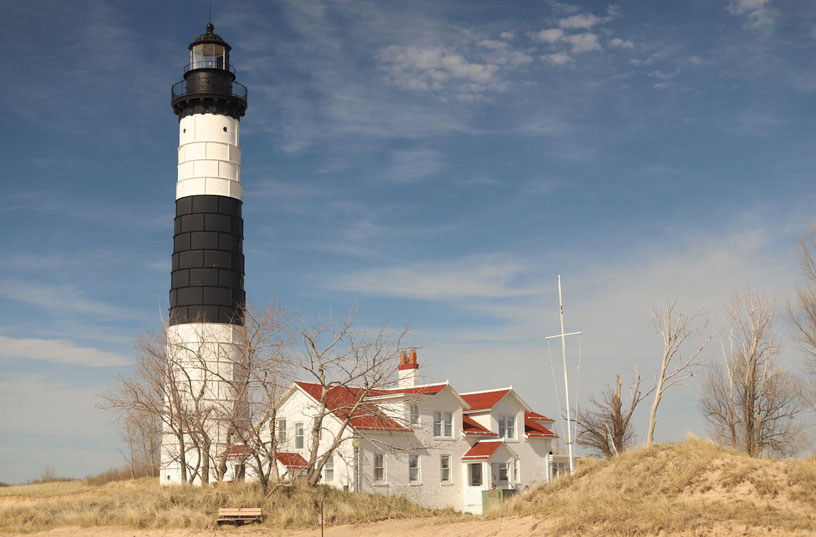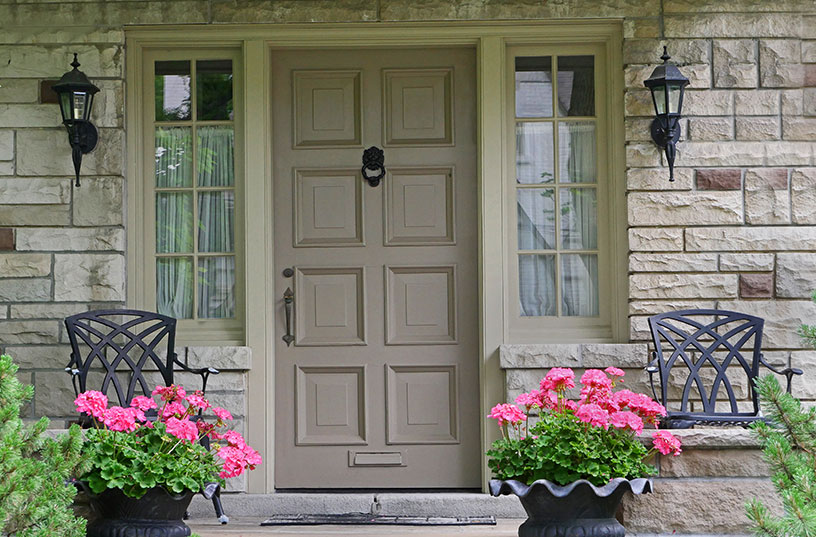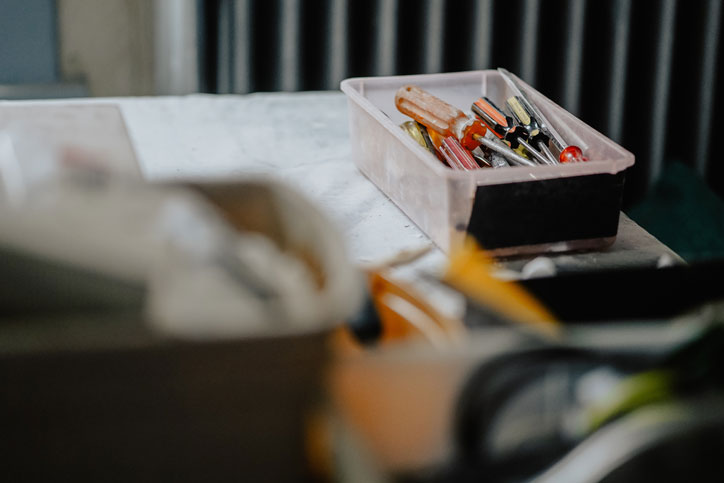For most people, their house is their biggest investment and asset. It’s also a place where memories are made and stored, where you find comfort, and feel secure. So of course, you want to protect your home, both inside and outside. It may seem like a daunting task, but with some simple precautions, a little planning, and today’s high-tech tools, safeguarding your sanctuary is easier than ever.
FROM THE OUTSIDE
The elements can be hard on your house. Rain, snow, sleet, hail, high winds, and even intense heat can all damage your house. Not to mention those pesky critters that find their way in! Sadly, we must also protect against break-ins and theft. According to the Insurance Information Institute (III), property damage, including theft, accounted for 97.7% of homeowners insurance claims in 2020 and the average claim was over $13,000.
Fortunately, there are many ways to reduce the odds of property damage and theft, including:
1. Inspect the Roof
“The time to repair the roof is when the sun is shining.” This quote by John F. Kennedy is wise in many ways! Too often, homeowners wait until there is a leak before thinking about the roof. But little leaks can lead to major damage over time, including a total roof replacement. A new roof can cost, on average, $8,000 to $10,000. How do you spot potential problems?
First off, please don’t climb on your roof! It’s too dangerous. Your best bet is to hire a professional to do a roof inspection, which involves checking your home’s interior walls and ceilings, attic, perimeter, exterior, and the rooftop itself. An inspection can identify where moisture might be seeping in, as well as cracked, curled or missing shingles. The flashing around chimneys, vents and skylights are also common areas of concern.
While many contractors offer free inspections, you’re probably better off hiring a professional inspector. Contractors typically do inspections as a potential first step to paid work, such as replacing your roof. The National Roof Certification and Inspection Association (NRCIA) recommends an annual inspection, which is typically $400 for a 2,500-square-foot home. You can find a directory of members on their website (nrcia.org). Locally, we recommend Fisher Home Inspections, LLC, a top-rated home inspection company.
2. Clean the Gutters
It’s a dirty job, but someone has to do it! If your gutters are filled with leaves, pine needles, and other debris, they can’t do their job, which is to funnel water away from the house. Water that seeps over the edge of your gutters and pools around the foundation will often find its way into your home, causing water damage. If you live in a cold climate, the water that collects in the gutters can freeze and form ice dams, which can damage the gutters and prevent them from routing melting ice away from your home.
You can tackle cleaning the gutters yourself (please be careful on those ladders!) or hire a service. Professionals recommend cleaning out your gutters twice a year (spring and fall). Costs can vary depending on your location and the size of your house, but the national average is about $160 per cleaning. Another option is to install a gutter-guard system which prevents leaves and debris from collecting in the gutters. These systems range between $100 and $2,000 per foot installed, depending on the material you choose. Steel mesh is considered the most durable.
3. Prevent Hail Damage
The National Weather Service’s Storm Prediction Center has recorded 4,834 reports of hail across the U.S. as of mid-July this year. That’s about 9% higher than last year’s total of 4,436. Of course, the likelihood of hailstorms depends on where you live. Here in Michigan, we see an average of 75 hailstorms per year. Hail can damage outdoor equipment and lead to water damage. Therefore, it’s recommended that you cover your air conditioner, grill, pool mechanicals, or any other major equipment. These specialty covers are often made with breathable mesh that doesn’t interfere with functioning. They can be purchased online for about $40.
4. Check Trees and Debris
This year has been particularly hard on trees, especially in the Midwest. Ice storms, strong winds, and heavy rains have toppled many trees. If a heavy limb or a large tree hits your roof, windows, or even your car, the damage can be extensive. To prevent this type of damage, hire a trained arborist to do a check around your home. They can identify vulnerable trees that are too close to your house, as well as assess the health of trees. They may also recommend trimming large branches. The cost of professional tree trimming or removal services varies greatly, depending on the size of the tree and how much pruning is required. You can keep small branches safely trimmed with hand pruners or a pole saw. Locally, we recommend Relief Pro Tree Service, LLC for dependable service.
It’s also advisable to keep debris and dead plants away from your home’s exterior. This type of debris poses a serious fire risk. Experts recommend maintaining at least a 5-foot-buffer around your home that’s free of dead bushes, trees, and other plants, as well as any debris.
5. Get a Chimney Shield
Open chimneys are very inviting to birds, squirrels, bats, and other critters. To keep wildlife out of your house, consider installing a chimney cap, which typically costs about $300. Caps made of wire-mesh are your best bet. They can also reduce the likelihood of embers drifting out of your chimney and starting a fire.
6. Inspect and Clean Your Septic System
According to the Environmental Protection Agency (EPA), the average household septic system should be inspected at least every three years by a septic service professional. In addition, household septic tanks are typically pumped every three to five years. Some signs that your septic needs cleaning include pooling water in the yard, foul odors, slow drains, sewage backup and dead or dying grass in the drain field. It’s far more cost effective to do regular maintenance and upkeep than fix major problems. You can find tips for the best ways to care for you septic system here. Locally, we recommend All American Septic Service for reliable inspections and cleaning.
7. Beef Up Security
To prevent burglaries, there are both high-tech and low-tech measures you can take. Of course, the most common and effective deterrent is installing a security system. Installing a security system might also save you some money on your insurance premium, depending on your carrier and the type of system you choose. Security systems run the gamut from simple to sophisticated, so be sure to do some research before choosing one that fits your needs. Security cameras are also an option. Today, there are many DIY systems, such as those from Ring and Simplisafe, which are fairly easy to set up and can be operated via an app on your mobile device.
Experts also recommend removing dense shrubs or bushes close to your home, which provide convenient hiding spots. It may seem like common sense, but it’s also important to evaluate your doors and windows. Are they metal or solid wood? Are the locks effective? Do you have a security bar in your sliding patio doors? Do the locks on your windows work? Finally, a simple but effective preventive measure is good exterior lighting, including motion sensor bulbs near entrances.
ON THE INSIDE
1. Install Proper Devices
Every home should have smoke and carbon monoxide monitors on each floor, especially in or near bedrooms. Working alarms are the single most important way to prevent fatal fires and CO poisoning. You can find combination smoke and carbon monoxide detectors that are reliable. The bottom line: they save lives!
Smart thermostats are also a good investment. These devices connect to a smart phone app, which allows you to remotely control your home’s heating and cooling. Not only is this convenient and potentially cost saving, it can help you avoid disasters during an unexpected freeze or heat wave while you’re away. Temperatures below 32 degrees can freeze pipes and lead to damage. Experts suggest setting your thermostat well above that temperature – 65 degrees or higher – to make sure that areas inside your walls where the pipes are stay safe.
Heat and humidity can also wreak havoc on your home. The EPA recommends maintaining indoor humidity levels in the 30 to 50 percent range to avoid mold, mildew, and bacteria growth.
Last, but not least, are leak detectors. Leaks are sneaky – they often go unnoticed until significant water damage occurs (i.e., behind walls, under sinks and applicances). Leak detectors monitor the flow rate in pipes in your main water supply or detect water leaking onto the floor. These devices can be put under sinks, near your washer and dryer, or by exterior walls. Detectors can be security system add-ons or purchased separately. Some can even turn off the water if a leak is detected.
2. Perform a Fire Safety Check
An estimated 358,500 home fires occur every year. Of these, 50% start in the kitchen, 7% begin in the bedroom, 4% start in the living room, 3% in the laundry room, and 6% are chimney fires. Many of these fires cause injuries and deaths, not to mention extensive property damage. In addition to working smoke detectors, there are many simple things you can do to help prevent home fires. Start by asking any smokers in your household to only smoke outside and always douse cigarette butts. Never leave a candle burning unattended. Also, be sure to keep any combustible materials, such as paper, away from space heaters and always turn those off when you leave a room or go to bed. Finally, be sure to change the batteries in smoke and CO detectors – a good rule is to change batteries whenever clocks spring forward or fall back.
3. Maintain HVAC Systems
Your heating, ventilating, and air conditioning (HVAC) systems work hard to keep your home comfortable. To keep them running smoothly, it’s important to have systems inspected every year. The average cost of HVAC inspections is between $75 and $200, but it can save you money in the long run by keeping your systems running economically and preventing costly damage/replacement. Locally, we recommend Holdwick’s Heating and Cooling for reliable service.
HAVE PROPER INSURANCE
Despite your best efforts, it’s likely that your home will suffer some type of damage over the years, either due to weather, accidents or simple wear and tear. While most homeowners have insurance policies, experts say 64% of homeowners are underinsured, by an average of 27% of their home’s value! To avoid an expensive surprise, be sure to evaluate your policy and understand exactly what it covers. Read through the policy carefully and ask questions about areas that seem unclear.
Some questions to ask include: Are exterior structures like sheds covered? Are you covered for replacement cost or actual value of appliances? Are your valuable possessions, such as artwork or jewelry covered? Does your policy include flood insurance? (If you live in a flood zone, your lender may require flood insurance. If you’re not in a flood zone, you may want to add it. Flood risks across the U.S. are increasing.) Do you have sewer- and water-pipe coverage? Does the policy cover wind and hail damage? What is the amount of the deductible for this damage? Does the policy cover additional living expenses if you need to move or rent while damage is being repaired? This list is not exhaustive. Our best advice is to talk with an insurance professional about all aspects of your homeowner’s policy. Locally, we recommend Yarbrough Insurance Group for trusted advice.
As mentioned, the biggest investment most people make is in their home. Protecting this asset, as well as your family, can provide some much-needed peace of mind.










